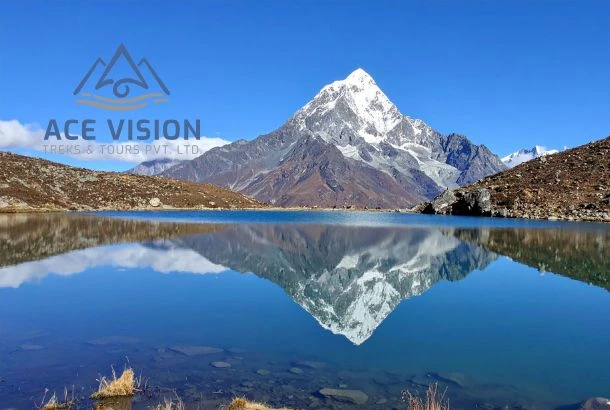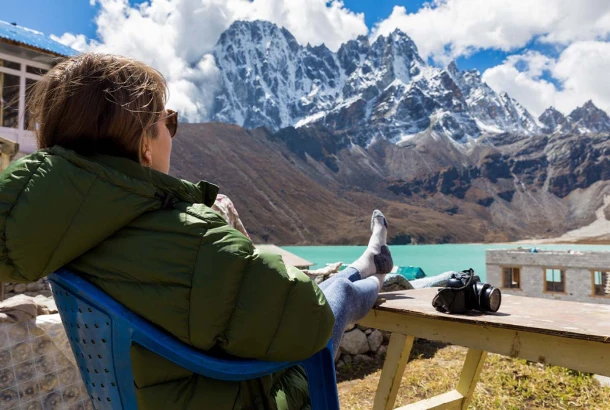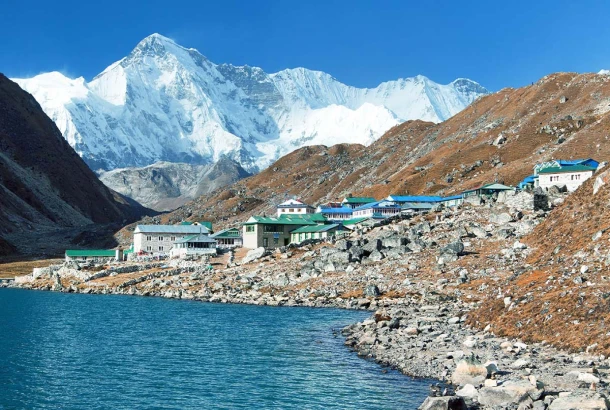Why do you need to choose a season for Mustang?
The best time to visit Mustang largely depends on what exactly the visitors want to get from the experience. This region is more than just about landscapes; it’s about stories, rituals, and rhythms that change with the seasons. Also, no matter what took you here for trekking, culture, or spirituality, the right time will ensure your journey is a much more fulfilling one.
If, however, traveling is your goal, you may visit the area in late spring (April–May) or autumn (September–November) if it’s trekking you seek. The months have clear skies, stable weather, and easy trail conditions. The dusty desert terrain of Upper Mustang is more welcoming, and the mountain views are sharp and unforgettable. At this time, the region is open and lively with other fellow trekkers on the trail and teahouses running at full service.
If travelers want cultural depth, coming with the local festivals such as Tiji in Lo Manthang (usually in May) will give them a very rare peek into Mustang’s Tibetan-influenced traditions. Masked dances, chants, and community get-togethers bring visitors in touch with Mustang’s spiritual core, while the energy this three-day celebration brings is unmatched.
The shoulder months, or even winter, can be tremendously still if being alone and reflective are high priorities. Less cold and more remote, these periods are drawn out from the tourist crowd, which provides a space for personal clarity and quiet absorption, for instance, to visit monasteries, meditate, or take photos.
Match your purpose to your trip. In every season, Mustang has something unique to give and you just have to know what you want and when the land is ready to give it.

Best Time to Visit Mustang | Month-by-Month Guide
Summer (June to August)
Although it is monsoon season, Mustang is still a good visit in summer. However, because Mustang stays in the rain shadow of the Himalayas, you won’t see much rain there. The climate can be a little balmy, but with dry air, it is easy and pleasurable to travel. It’s a bit quieter for this season with fewer tourists on the trails, so it’s great for people who enjoy quieter travel.
The Yartung Festival is celebrated in different villages like Muktinath and the local one, Lo Manthang, is in August. In addition, this festival includes horse racing, singing, dancing, and prayers. Also, you have the opportunity to see more of local life; the culture of Mustang warms as time passes. However, despite it being summer, Mustang has dry paths, open skies, and strong cultural vibes.
Autumn (September to November)
Another season during which Mustang is especially popular is autumn. The skies are very clear, and the way is great for trekking and sightseeing after the summer. On the day it is cool and at night slightly cold, for comfortable walking. This season is the most popular because the mountains look breathtaking and the air feels fresh and refreshingly clean.
There are travelers in the villages, and life is full of light and bustling around. The beauty of the place is that the dry land has the golden color seen in autumn. Photography and cultural tours are also a good idea at this time. Perhaps autumn is the best of Mustang, with perfect weather, stunning views, and warm hospitality.
Winter (December to February)
Mustang is incredibly harsh in winter, very cold, and very quiet. The high passes are often covered with snow, and some villages are as well. At this time, many locals leave for warmer places while some guesthouses and services shut down. Even the roads could get blocked, and trekking would become harder with ice and snow. Of course, if you like snow, you like minimalistic scenery, and you like quietness, winter can be cool as well.
For you, that perspective will reveal a different side of Mustang: silent, peaceful, and with the beautiful, untouched natural beauty. However, visitors must be well prepared going in for the cold, and it is better to check the road and the weather before hitting the road.
Geography and Climate of Mustang
Nepal’s Mustang is not one of the regions to be compared when it comes to geography. It is in the rain shadow of the Annapurna and Dhaulagiri ranges and gets very little rain. One of the few Lower and Upper Mustang districts subdivisions of Mustang, and both places have their climate, region, and traveling terms.
The places in the lower Mustang include Jomsom, Marpha, and Kagbeni. Due to road access and a small airport in Jomsom, it is easier to reach this region. Here altitude lies between 2,700 and 3,000 m. The climate is cool and windy with little rainfall in monsoon months (June to August), but much less than in other parts of Nepal.
If the Mustang is higher and more remote, then so is the Upper Mustang. This is between 3,000 and 4,000 meters and is close to the Tibetan border. It is a high-altitude desert with cliff faces, deep gorges, and wind lashed valleys. A rarity in Nepal (as well as India, Thailand, and most other tropical countries), trekking in the region during summer is a good option, as the region gets very little rain even during the monsoon.
Considering the geography of the place, the Upper Mustang remains closed during the heavy winter months (December to February) because it can be hard to travel during this season because of snowfall and freezing temperatures. On the contrary, spring and autumn are both good times to visit both Lower and Upper Mustang, since temperatures are mild, skies are clear, and road or trekking conditions are safer.
This helps you plan better because there are regional differences to understand. Lower Mustang has culture, is comfortable, and is more accessible. Upper Mustang has no equals for remote trails, ancient caves, and raw landscapes, but arriving at the right time of year is essential to the full enjoyment of those landscapes.

Festivals and Cultural Highlights of Mustang
Mustang is a land of ancient culture and ancient traditions. Tibetan Buddhists are practiced by people in this area. All year they celebrate colorful and exciting festivals. Māori created these festivals for more than fun. They too show the strong spiritual beliefs of the people. Visiting Mustang during one of these festival days will reveal dances, music, horse racing, and prayer ceremonies.
First of all, we’ll look into two of the most popular festivals in Mustang, the Tiji, and the Yartung festivals.
Tiji Festival (May)
Of all the festivals, the most famous and important festival in Upper Mustang is the Tiji Festival. Every year it takes place in the walled city of Lo Manthang in May. The word “Tiji” is derived from a larger word that means ‘hope for peace.’ The theme of good triumphing over bad is celebrated during this festival; that is, this festival promotes the protection of the land from bad spirits.
It is a three-day festival. People from all over Mustang and from other parts of Nepal will come to Lo Manthang at this time. However, they tend to join in the celebrations wearing the traditional costumes.
The principal event consists of a set of mask dances by the monks in colorful costumes. Here these dances depict the tale of a god, Dorje Jono, who fights a demon in order to save Mustang from destruction. The monks stand in slow, graceful steps and circle each other with props, and some dancing. Their ace is calm and serious, and their air is filled with the music of drums and horns.
The last day of the festival is climactic when they still take the model of the demon and burn it. This shows that good has won. The people cheer and are happy and joyful for their future. The Tiji Festival is not just a show. This is an event that requires a spiritual aspect and brings the community as a whole together. Visitors find it a great time to visit the place and explore the beauty of Mustang along with learning the culture. You can see this festival in mid to late May, and that’s the best time if you want to go there.
Yartung Festival (August)
Another feast celebrated in Mustang is the Yartung Festival. Usually, such a thing happens in August after the sowing of the crops. This is a season when people have time to relax, have fun, and say thank you to the gods for blessing them.
The horse race is special at Yartung. During this festival, men and women ride horses as fast as their horses will go over the open land. Some have flags or swords and others have traditional dress. The energy is very high, and the crowd cheers loudly.
However, importing Yartung means more than just racing. It also includes spiritual ceremonies. Prayers and blessings for the health and happiness of the people are led and offered by the monks. Songs, dances, and feasts are there. Young and old, local and visitor, everyone joins the fun.
Most festivals of the festival are for several days and are being held in some villages in the Muktinath and Lo Manthang. The event gains its flavor from each place. Along with bathing in holy water, they visit the famous temple in Muktinath during Ashad.
Yartung is a mixture of culture, religion, and community, which is joyful. If you would like to see strong traditions and real local life, it is a great time to visit Mustang.

Historical Importance and Spiritual Relevance of Mustang
The monasteries in Mustang are very old and also special. Buddhist monks built them several centuries ago. For example, they are not only places of prayer, but they are full of art, history, and tradition. Mustang monasteries are known to have been centers of learning, where monks used to study religious texts, medicine, and astrology. They are still frequented by people who come and pray, ask for blessings, and participate in local festivals. The Mustangs’ undying faith and culture are represented in these sacred places.
Lo Gekar Monastery
According to the story, Lo Gekar Monastery is the oldest Buddhist monastery in Nepal. It is located near the village of Ghami in Upper Mustang. The monastery here was constructed by Guru Rinpoche, also known as Padmasambhava, in the 8th century. They believe he beat evil spirits in order to build the monastery. Whether you are inside or not, there are old paintings to see and deep spiritual energy to feel. It is a quiet and peaceful place.
Thubchen Gompa
Lo Manthang is an ancient city, and the Thubchen Gompa is situated there. Founded in the 15th century, one of the largest monasteries in Mustang is being built. On the inside walls, there are colorful paintings of Buddhas and stories from Buddhist texts. It has a large ceiling and high wooden pillars. It is a popular place for monks to perform traditional dances here during the Tiji Festival in May, and many people gather for celebrations. The time is very nice to visit.
Chhoser Cave Monastery
Inside a cliff near the village of Chhoser, Chhoser Cave Monastery is built. Hand-carved rooms and prayer halls for the monks. They had lived and meditated in the cave. It is as though walking through its narrow paths is walking back in time. The place is peaceful, a place to imagine how the monks who lived here lived.
Jhong Cave
Chhoser is also near Jhong Cave. The Sky Caves of Mustang are as famous as this one. There are more than 40 rooms at more than one level in this cave. There were some rooms set apart from each other similar to what a monastery is and had small altars and prayer areas. There are amazing views of the Mustang Valley to see from the top of the cave.
Accommodation Options and Availability by Season
Mustang has basic teahouses and comfortable lodges, with availability and quality varying throughout the seasons. With proper planning, you need to decide where and when to stay, a key decision that significantly matters in the overall comfort and smoothness of your journey.
Spring
Most teahouses and lodges in both Lower and Upper Mustang are running during peak seasons from spring (March to May) and autumn (September to November). In these months, there are the most trekkers; thus, rooms get booked quickly, especially in the most popular stops such as Jomsom, Kagbeni, Marpha, and Lo Manthang. As these are the high season times, booking in advance will not go unappreciated, by doing it either directly or through a trekking agency. Therefore, facilities are better kept during peak season, the food menu is more complete, and staff are available.
Summer/Monsoon
Lower Mustang also has fewer visitors because of slippery roads and rainfall in the monsoon season (June to August) which leads to problems in transportation and comfort. Although it is in a rain shadow, Upper Mustang is accessible and receives some trekkers. However, accommodation is less crowde,d and advance booking is not necessary unless it is for a big event such as the Yartung Festival.
Winter
The quiet season is winter (December to February). During the extremely cold months, and due to poor tourist flow, many guesthouses in Upper Mustang shut down. Some lodges even operate with limited services in Lower Mustang. Hotels may have rooms; however, the heating is minimal, and the food might be minimal and basic. Traveling in winter will require careful planning, confirming open lodges, and very cold nights, too. It is the right time to choose your trekking conditions and also rest for your comfort. This helps you avoid surprises when you’re visiting, and you can enjoy your visit to the fullest.

Final Say
Mustang’s no one-place-and-square type of deal; there’s no best time to visit Mustang, only the best time to take the journey. Timing is everything when it comes to visiting Nepal—it can mean the difference between stunning slabs of snowcapped peaks and rocky skies. Mustang is made for those who travel with purpose. Seasonally, the region changes, and each change brings something with it hyperactive celebrations or silent, snow covered trails.
The most important thing is to match up your visit with what it is that you want on the trip. Regarding adventure, spring and autumn will provide the best trekking conditions. But if it’s culture, May is your time. Still, maybe you’ll be surprised that winter offers the solitude and silence you may need. Plan but be flexible, and let the land dictate your timing. The rhythm of Mustang is its own, and listening to that rhythm and syncing up with it is unforgettable.
This might interest you :-










